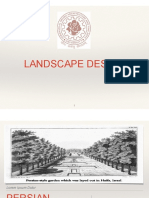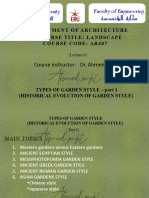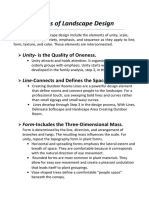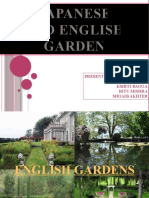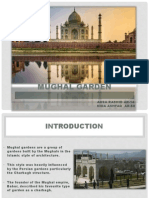Ancient Gardens
Ancient Gardens
Uploaded by
Emmanuel IICopyright:
Available Formats
Ancient Gardens
Ancient Gardens
Uploaded by
Emmanuel IIOriginal Description:
Copyright
Available Formats
Share this document
Did you find this document useful?
Is this content inappropriate?
Copyright:
Available Formats
Ancient Gardens
Ancient Gardens
Uploaded by
Emmanuel IICopyright:
Available Formats
ANCIENT EGYPTIAN GARDENS (2600 -31 BC)
The gardens of ancient Egypt probably began as simple fruit orchards and vegetable gardens, irrigated with water from the Nile. The earliest gardens were composed of planting beds divided into squares by earthen walls, so the water could soak into the soil rather than run off. Gardens belonged to temples or the residences. Secular gardens were located near the river or canals, and were used mainly for growing vegetables. Beginning with the New Kingdom, gardens were attached to more luxurious residences, and were sometimes enclosed by walls. Temple gardens were used to raise certain vegetables for ceremonies, gradually as the country became richer; they evolved into pleasure gardens, with flowers, ponds and alleys of fruit and shade trees. Temples, palaces, and private residences had their own gardens, and models of gardens were sometimes placed in tombs so their owners could enjoy them in their afterlife. Ancient Egyptian gardens often consisted of both trees and other plants. There were about eighteen varieties of trees grown by the Egyptians. Popular trees included the sycamore fig, pomegranate, nut trees and jujube. The Pink flowered tamarisk, acacia and willow trees were common in gardens.
ANCIENT GREEK GARDENS (480 -146 BC)
The Ancient Greeks were filled with amazement when they first beheld the magnificent parks of Eastern potentates. Their own civilization had produced nothing to compare with the achievements of these mighty satraps and imperial kings. In the best period, when the other arts in Greece were rapidly advancing to their highest point of development, we hear nothing about Greek garden culture. Nor, through excavation, do we expect any satisfactory evidence of this most perishable of all the arts. Moreover, the witnesses who give us pictures of Oriental and Egyptian gardens poets, historians, and paintersare silent here. So it is only by listening for chance remarks in literature that we can trace any development of the Greek gardens, so simple yet so important in its results.
ANCIENT ROMAN GARDENS (27BC -476 AD)
Roman gardens began as practical features. Large or small, they were sources of vegetables, herbs and fruit for the household. However by the imperial period any garden of significant size incorporated plants, water features and statues into a careful designed haven for the gardens owner. Archaeological remains can be interpreted using ancient source material to recreate the layout and plants most commonly found in Roman gardens. Private Roman gardens were generally separated into three parts. The first, the xystus, was a terrace that served as an open air drawing room and connected to the home via a covered portico. The xystus overlooked the lower garden, or ambulation. The ambulation consisted of a variety of flowers, trees, and other foliage and served as an ideal milieu for a leisurely stroll after a meal, some mild conversation, or other Roman recreation activities. The gestation was a shaded avenue where the master of a home could ride horseback or be carried by his slaves. It generally encircled the ambulation, or was constructed as a separate oval shaped space.
ANCIENT CHINESE GARDENS (1600 BC -1279 AD)
Classical Chinese gardens and parks combine classical Chinese architecture with painting, calligraphy, poems, carving
and horticulture, while offering living places and practical functions. They feature a natural landscape in order to give the onlooker a feeling of perfect harmony between man-made and natural beauty. Chinese gardens generally consist of halls, towers, pavilions, kiosks, terraces, waterside gazebos, covered corridors, hills, and ponds or lakes. A variety of garden-building techniques, accumulated by ancient Chinese designers, have made the scenery of the gardens look changeable, thus adding artistic appeal to the gardens. A Chinese garden was not meant to be seen all at once; the plan of a classical Chinese garden presented the visitor with a series of perfectly composed and framed glimpses of scenery; a view of a pond, or of a rock, or a grove of bamboo, a blossoming tree, or a view of a distant mountain peak or a pagoda.
JAPANESE GARDENS (575 -1600 AD)
A unique style of Japanese gardening evolved during the Heian Period known as Shinden-zukuri. Such a garden was positioned in front of the palace with an artificial water passage leading water into a pond. The pond would have islands in it. The layout of the Heian gardens generally followed the Chineseinspired principles of geomancy (feng shui), including the idea that the pond should be created by a stream entering the garden area from the northeast (the realm of the Blue Dragon, the Chinese and Japanese Guardian of the East) and exiting at the southwest (the realm of the White Tiger, Guardian of the West). As Wybe Kuitert has pointed out, however, this geomantic prescription actually corresponds to the natural flow of water in the plain on which Kyoto is situated. The pond itself would have had one or more islands and peninsulas accessible by bridges built high enough to allow boats to pass. In the usual layout, one or two of the covered corridors of the villa would have terminated in a "fishing pavilion" ( tsuri dono) (B) and/or a "spring pavilion" (C) overlooking the pond.
MEDIEVAL EUROPEAN GARDENS (500 -1200 AD)
Medieval gardening, or gardening during the medieval period, was the chief method of providing food for households, but also encompassed orchards, cemeteries and pleasure gardens. The European medieval era will be considered to span, though appropriate references may be made to earlier and later times. Gardening is the deliberate cultivation of plants herbs, fruits, flowers, or vegetables. The aromatic and medicinal herbs garden separate from the vegetable garden, the orchard, and the garden of bouquet flowers grown to adorn the altars. Little room is left for recreation as everything is productive when there are many mouths to feed.
MOORISH GARDENS
In Spain in VIII - XIV c. A.D., after its conquest by the Arabs (the Moors), appears the special form of garden called the patio. This is a closed type of garden, in which the ancient traditions and Persian gardens merged during its development. The oldest of the still existing, preserved Moorish gardens is the patio of the palace ensemble in Grenada. The garden is isolated on the terraces, it is limited by the colonnades of towers, palaces and walls. The patio's purpose is to provide a place for relaxation, meditation and contemplation; therefore the presence of ponds, fountains, tile mosaics and concise gardening is characteristic of it. The nature of the Moorish garden - is the simplicity of planning and the uniqueness of the solution. Water is the primary motif of the garden. In the regular planning style a courtyard - patio is always present. Specific points are arranged and arcades take shape. The plants are exotic and correspond to the climatic conditions: mandarins, cypresses, oranges and oleanders. They are planted freely and trimming, for the most part, did not adapt. Lawns were not used because of the hot climate and the territory took shape through decorative paving - this is one of the key elements of Moorish garden.
Cultural bloom at this time was observed, many cities from India to Spain were proud of their gardens. In order to give the gardens a certain charm irrigation systems built by Romans were used. Fountains never contained the imprint of the human essence, the artists ideas were never combined with man or his humanly form since the Koran forbids the depiction of the exposed body. Furthermore, designers were more restrained in the estimation of a quantity of utilized water (if we do not consider some Turkish gardens), although this restraint was always found in balance with a feeling of aesthetical "completeness", self-sufficiency of a garden.
You might also like
- European Gardens History Philosophy and Design PDFDocument2 pagesEuropean Gardens History Philosophy and Design PDFSheilaNo ratings yet
- The Hollywood Reporter May 31 2023Document98 pagesThe Hollywood Reporter May 31 2023M. WoodsNo ratings yet
- Evolution of The Ancient Greek GardenDocument17 pagesEvolution of The Ancient Greek GardentojolabalNo ratings yet
- History of Garden DesignDocument52 pagesHistory of Garden DesignShah Syed Zubair Ahmed100% (1)
- Landscape 3Document64 pagesLandscape 3lakshmi akshaya maddiNo ratings yet
- Islamic Gardens in Iran - DaneshdoostDocument10 pagesIslamic Gardens in Iran - DaneshdoostarashboostaniNo ratings yet
- Philippine Laws On Housing and Human SettlementsDocument11 pagesPhilippine Laws On Housing and Human SettlementsEmmanuel II100% (1)
- BP 344 Accessibility Law With IllustrationsDocument30 pagesBP 344 Accessibility Law With IllustrationsEmmanuel II100% (1)
- SPOG-5-1002 Cease and Desist LTRDocument6 pagesSPOG-5-1002 Cease and Desist LTRpmocekNo ratings yet
- Roman GardensDocument4 pagesRoman GardensJulioAranedaNo ratings yet
- History of GardensDocument22 pagesHistory of GardensJawed AmirNo ratings yet
- Gardens of Civilizations Part I-Greek Rome MedievalDocument57 pagesGardens of Civilizations Part I-Greek Rome MedievalMiriam AzarNo ratings yet
- Lecture 8 - Types of Garden Styles - Part 1Document24 pagesLecture 8 - Types of Garden Styles - Part 1Rewaa MerwadNo ratings yet
- The Egyptian GardensDocument10 pagesThe Egyptian GardensHajiraNo ratings yet
- History of Garden Design Compressed 12-08Document33 pagesHistory of Garden Design Compressed 12-08Pulkit Taluja100% (1)
- Japanese Garden: Mitakshi Chouhan M.Arch 20MAR1001 Chandigarh UniversityDocument23 pagesJapanese Garden: Mitakshi Chouhan M.Arch 20MAR1001 Chandigarh UniversityMitakshi ChouhanNo ratings yet
- History of Garden Design in AustraliaDocument7 pagesHistory of Garden Design in AustraliaHeeSeup ShinNo ratings yet
- Italian Renaissance GardensDocument22 pagesItalian Renaissance GardensSaurabh Prasadi100% (5)
- Subject Theory of Landscape Architecture Assignment Gardens of GreeceDocument6 pagesSubject Theory of Landscape Architecture Assignment Gardens of Greecearti koshalNo ratings yet
- Zen GardenDocument10 pagesZen GardenRoopali GuptaNo ratings yet
- Lecture 1 - The History of Landscape Design PDFDocument16 pagesLecture 1 - The History of Landscape Design PDFDawod AbdieNo ratings yet
- Evolution of Garden Design: M.Arch Landscape Assistant Professor GITAM School of Architecture Hyderabad Prepared byDocument23 pagesEvolution of Garden Design: M.Arch Landscape Assistant Professor GITAM School of Architecture Hyderabad Prepared bynihaNo ratings yet
- Drought Tolerant Planting KENT WILDLIFE TRUSTDocument2 pagesDrought Tolerant Planting KENT WILDLIFE TRUSTglynisNo ratings yet
- Landscape Design StyleDocument12 pagesLandscape Design StyleAde KurniawanNo ratings yet
- Roman Garden: Submitted By: Khushi Bajoria Neelam Chandrakar Shanti DengwaniDocument18 pagesRoman Garden: Submitted By: Khushi Bajoria Neelam Chandrakar Shanti DengwaniKhushi BajoriaNo ratings yet
- HISTORY LandscapeDocument45 pagesHISTORY Landscapeadarshareddy100% (1)
- Greek GardenDocument40 pagesGreek GardenVijetha CPNo ratings yet
- L-8 Salient Features of Persian and Mughal GardenDocument42 pagesL-8 Salient Features of Persian and Mughal GardenShruti Nagpal Kapur83% (6)
- Landscape ArchitectureDocument36 pagesLandscape ArchitectureMariz Aina LoberianoNo ratings yet
- Zen GardenDocument13 pagesZen GardenLavina Jain100% (1)
- The Paradise Garden - A Model For Designing For Those With Dementia and AlzheimerDocument9 pagesThe Paradise Garden - A Model For Designing For Those With Dementia and AlzheimeraldaNo ratings yet
- English Gardens: Submitted By: TANVI MUTNEJA (7022) SANGEETA (7016) VIDISHA DAS (7025)Document46 pagesEnglish Gardens: Submitted By: TANVI MUTNEJA (7022) SANGEETA (7016) VIDISHA DAS (7025)ruksarNo ratings yet
- Garden History + Persian Gardens + Mughal GardensDocument49 pagesGarden History + Persian Gardens + Mughal GardensSakshi RawatNo ratings yet
- Principles of Landscape DesignDocument6 pagesPrinciples of Landscape DesignUbaid KhanNo ratings yet
- Garden History + Persian GardensDocument32 pagesGarden History + Persian GardensMrigya GuptaNo ratings yet
- Mughal GardensDocument46 pagesMughal GardensparvinmalickNo ratings yet
- Chinese GardensDocument17 pagesChinese GardensNidhi MehtaNo ratings yet
- By Akshay Sharma & Aditya VijayDocument15 pagesBy Akshay Sharma & Aditya VijayAkshay SharmaNo ratings yet
- Japanese GardenDocument13 pagesJapanese GardenMihaela At.No ratings yet
- Garden Design in History - Japanese & MughalDocument98 pagesGarden Design in History - Japanese & MughalHarshene KrishnamurhtyNo ratings yet
- Chinese Gardens: The Administrator's Garden at SuzhouDocument24 pagesChinese Gardens: The Administrator's Garden at SuzhouSithesh RNo ratings yet
- Landscape Architecture Lecture 4Document28 pagesLandscape Architecture Lecture 4Ali WAHEEDNo ratings yet
- Gardens of PersiaDocument20 pagesGardens of Persiasubash saravananNo ratings yet
- Asian Design in LandscapingDocument3 pagesAsian Design in LandscapingNorberto R. BautistaNo ratings yet
- Japanese Garden 11Document37 pagesJapanese Garden 11Harshita BhanawatNo ratings yet
- Landscape Design: Presented By: Anant Nautiyal, Dhir Dhwaj Singh, Gaurav Soni, Priyvarth Singh Arya, Rishabh Dev SharmaDocument23 pagesLandscape Design: Presented By: Anant Nautiyal, Dhir Dhwaj Singh, Gaurav Soni, Priyvarth Singh Arya, Rishabh Dev SharmaDhiksha KishoreNo ratings yet
- Landscape DesignDocument12 pagesLandscape DesignMaria Montemayor De Teresa100% (1)
- Japanese Gardens: Japanese Gardens Are Traditional Gardens That Create MiniatureDocument16 pagesJapanese Gardens: Japanese Gardens Are Traditional Gardens That Create MiniatureDEXTRO 000No ratings yet
- The French GardenDocument161 pagesThe French Gardendeliriousheterotopias100% (3)
- Zen Garden PDFDocument57 pagesZen Garden PDFIvy Joy Campos100% (2)
- Japanese Garden: Antariksh Agrawal Akash Paradkar Arti Kumari S.Sushrut Shivani Kumari Tara ChandDocument34 pagesJapanese Garden: Antariksh Agrawal Akash Paradkar Arti Kumari S.Sushrut Shivani Kumari Tara ChandAbhishek AkodiyaNo ratings yet
- Lodi Garden Tree Walk INTACHDocument3 pagesLodi Garden Tree Walk INTACHTanuj BiyaniNo ratings yet
- English Landscape GardensDocument40 pagesEnglish Landscape GardensAanchal Goel0% (1)
- English GardenDocument40 pagesEnglish GardenAbhishek AcharyaNo ratings yet
- Hertfordshire Garden History Volume 2: Gardens Pleasant, Groves DeliciousFrom EverandHertfordshire Garden History Volume 2: Gardens Pleasant, Groves DeliciousNo ratings yet
- Mughal GardenDocument19 pagesMughal Gardennoisysilence22291No ratings yet
- Japanese Miniature R CK Gardens: Zen Garden CDocument17 pagesJapanese Miniature R CK Gardens: Zen Garden CRamsrajNo ratings yet
- Therapeutic Garden Design Recommended Reading ListDocument16 pagesTherapeutic Garden Design Recommended Reading ListKritikou1547100% (1)
- Japanese Garden PlantsDocument7 pagesJapanese Garden PlantskattoralNo ratings yet
- Cantilever Beam (CB) : 4-.10M, 4-.15M REST at .20M.O.CDocument1 pageCantilever Beam (CB) : 4-.10M, 4-.15M REST at .20M.O.CEmmanuel IINo ratings yet
- Isometric Layout: General SpecificationsDocument1 pageIsometric Layout: General SpecificationsEmmanuel IINo ratings yet
- Schedule of Loads: Arch. Hervy G. Catilogo, UapDocument1 pageSchedule of Loads: Arch. Hervy G. Catilogo, UapEmmanuel IINo ratings yet
- Kanhuraw Site Devt - scalED-Layout1Document1 pageKanhuraw Site Devt - scalED-Layout1Emmanuel IINo ratings yet
- Riser Diagram: General SpecificationsDocument1 pageRiser Diagram: General SpecificationsEmmanuel IINo ratings yet
- Catch Basin Detail: On Vertical & Horizontal BarsDocument1 pageCatch Basin Detail: On Vertical & Horizontal BarsEmmanuel IINo ratings yet
- Detail of C1F1: SPCD. at 0.20 M.O.C. BothwaysDocument1 pageDetail of C1F1: SPCD. at 0.20 M.O.C. BothwaysEmmanuel IINo ratings yet
- Rafter Detail: 2 X 2 X Angle Bar As Top & Bottom Chord See Detail - GDocument1 pageRafter Detail: 2 X 2 X Angle Bar As Top & Bottom Chord See Detail - GEmmanuel IINo ratings yet
- Detail of Roof Beam: SectionDocument1 pageDetail of Roof Beam: SectionEmmanuel IINo ratings yet
- Plot Scale Drawing Units MM CM MDocument1 pagePlot Scale Drawing Units MM CM MEmmanuel IINo ratings yet
- Construction of Perimeter FenceDocument3 pagesConstruction of Perimeter FenceEmmanuel II0% (1)
- Disgrasya: By: Conrado de QuirosDocument6 pagesDisgrasya: By: Conrado de QuirosEmmanuel IINo ratings yet
- Fixing A Broken HeartDocument1 pageFixing A Broken HeartEmmanuel IINo ratings yet
- Architectural Program Form: Republic of The Philippines Tacloban CityDocument7 pagesArchitectural Program Form: Republic of The Philippines Tacloban CityEmmanuel IINo ratings yet
- Lot DescriptionDocument1 pageLot DescriptionEmmanuel IINo ratings yet
- Types of RoofsDocument4 pagesTypes of RoofsEmmanuel IINo ratings yet
- Types of RoofsDocument4 pagesTypes of RoofsEmmanuel IINo ratings yet
- Swatches 2Document2 pagesSwatches 2Emmanuel IINo ratings yet
- Introduction To The Fast Food IndustryDocument38 pagesIntroduction To The Fast Food IndustryAmit Kumar SinghNo ratings yet
- Tour Guiding Script For BataanDocument2 pagesTour Guiding Script For BataanMa Victoria Claire AureaNo ratings yet
- E-Commerce: The Second Wave Fifth Annual Edition: Planning For Electronic CommerceDocument37 pagesE-Commerce: The Second Wave Fifth Annual Edition: Planning For Electronic CommercesmilingalwaysNo ratings yet
- Worldwide Cost of Living 2016 ReportDocument13 pagesWorldwide Cost of Living 2016 ReportSouthern California Public Radio100% (1)
- MBA Organization Behaviour Management DRDocument27 pagesMBA Organization Behaviour Management DRThao TrungNo ratings yet
- Esp 2 - Practice - Midterm 1Document20 pagesEsp 2 - Practice - Midterm 1TashaSDNo ratings yet
- Latour Agencyatthe Timeofthe AnthropoceneDocument19 pagesLatour Agencyatthe Timeofthe AnthropoceneisagvidoNo ratings yet
- BUS 3305 Written Assignment Unit 5Document9 pagesBUS 3305 Written Assignment Unit 5Cherry HtunNo ratings yet
- Career Portfolio Cover LetterDocument5 pagesCareer Portfolio Cover Letterafjweyxnmvoqeo100% (2)
- BRC Global Standard For Packaging and Packaging MaterialsDocument5 pagesBRC Global Standard For Packaging and Packaging MaterialsCassilda CarvalhoNo ratings yet
- The Six Steps To Designing Programs With A Gender Lens When Engaging Men in Sexual and Reproductive Health and RightsDocument39 pagesThe Six Steps To Designing Programs With A Gender Lens When Engaging Men in Sexual and Reproductive Health and Rightssofiabloem100% (1)
- Pers Morales SYDO NON DGI Aout2017Document93 pagesPers Morales SYDO NON DGI Aout2017Hichem kingNo ratings yet
- Definition of Joint VentureDocument11 pagesDefinition of Joint VenturePravina BascranNo ratings yet
- PA Citizen's Audit of 2020 ElectionDocument27 pagesPA Citizen's Audit of 2020 ElectionRay BleharNo ratings yet
- Israeli Intelligence and SecurityDocument85 pagesIsraeli Intelligence and SecurityRonald Thomas WestNo ratings yet
- Joy To The World LyricsDocument3 pagesJoy To The World LyricsVilla Villacortes OrsolinoNo ratings yet
- The Secret Codes in The Scripture and The AlphabetsDocument61 pagesThe Secret Codes in The Scripture and The AlphabetsRichter, JoannesNo ratings yet
- Project 3 Final Draft: Take A Sad Song and Make It Better: Music As Healing inDocument7 pagesProject 3 Final Draft: Take A Sad Song and Make It Better: Music As Healing inapi-315910586No ratings yet
- Economy of CoimbatoreDocument9 pagesEconomy of CoimbatoreRangaraju PalanisamyNo ratings yet
- Thoopul AcharyanDocument19 pagesThoopul Acharyanapi-3715058No ratings yet
- Tourism Hospitality Industry Problems and Prospects of India 1698054501Document6 pagesTourism Hospitality Industry Problems and Prospects of India 1698054501Madhumita PatraNo ratings yet
- CAP2400S Airworthiness Code - InteractiveDocument81 pagesCAP2400S Airworthiness Code - InteractiveBhaskerNegiNo ratings yet
- U.S. Marines in Iraq 2003 Anthology and Annotated BibliographyDocument359 pagesU.S. Marines in Iraq 2003 Anthology and Annotated BibliographyBob Andrepont100% (3)
- Final Draft - From Art To Corporotisation - Arnav ShethDocument13 pagesFinal Draft - From Art To Corporotisation - Arnav ShethArnav ShethNo ratings yet
- Adl Refers To Justice' and Fairness' and Impartiality. Islamic LawDocument4 pagesAdl Refers To Justice' and Fairness' and Impartiality. Islamic LawViferlyn D. VillarNo ratings yet
- Without Love Chords LyricsDocument5 pagesWithout Love Chords Lyricstomkazas4003No ratings yet
- 5 Laureano v. CA SCRADocument2 pages5 Laureano v. CA SCRAcertiorari19No ratings yet
- Anheuser-Busch InBev Buys Corona Beer For $20.1 BillionDocument200 pagesAnheuser-Busch InBev Buys Corona Beer For $20.1 BillionBilly LeeNo ratings yet





